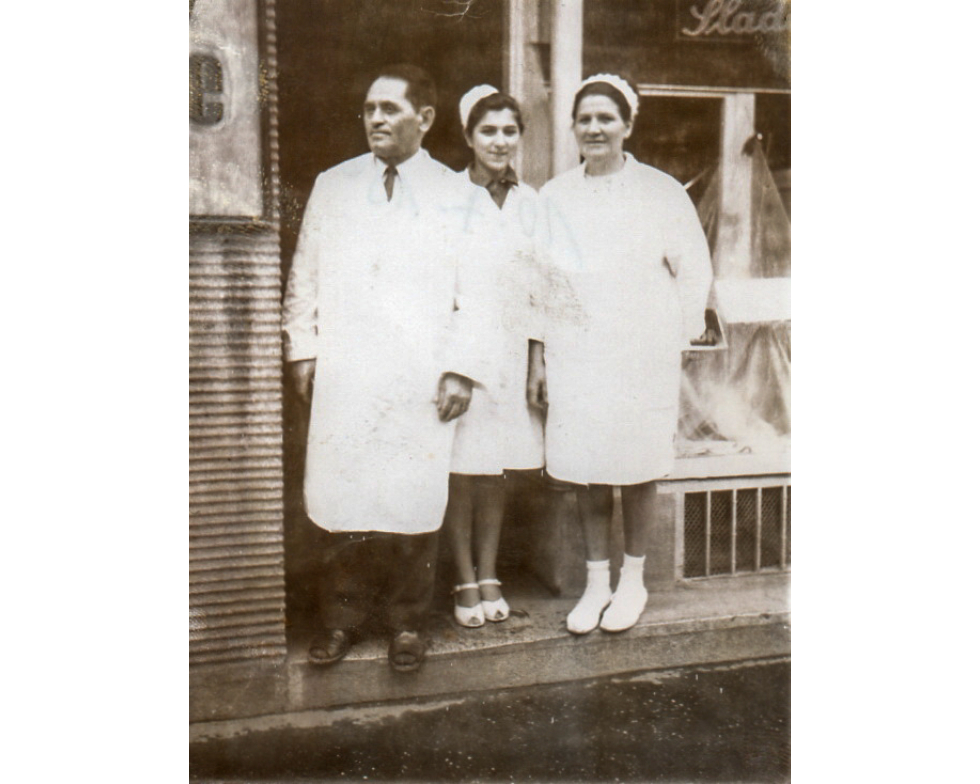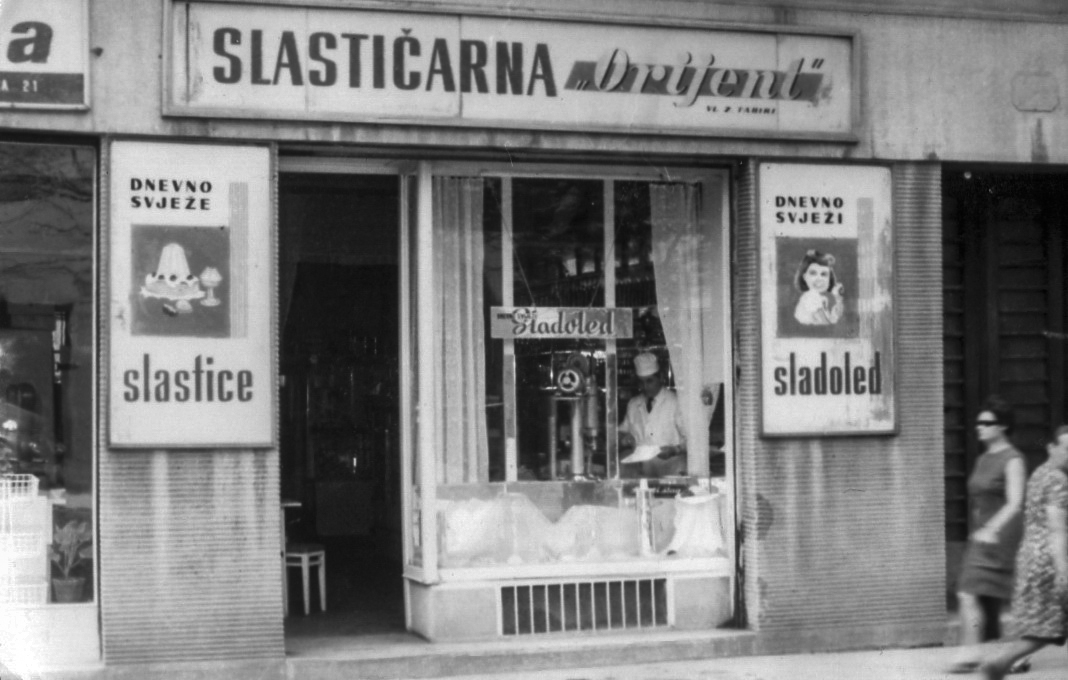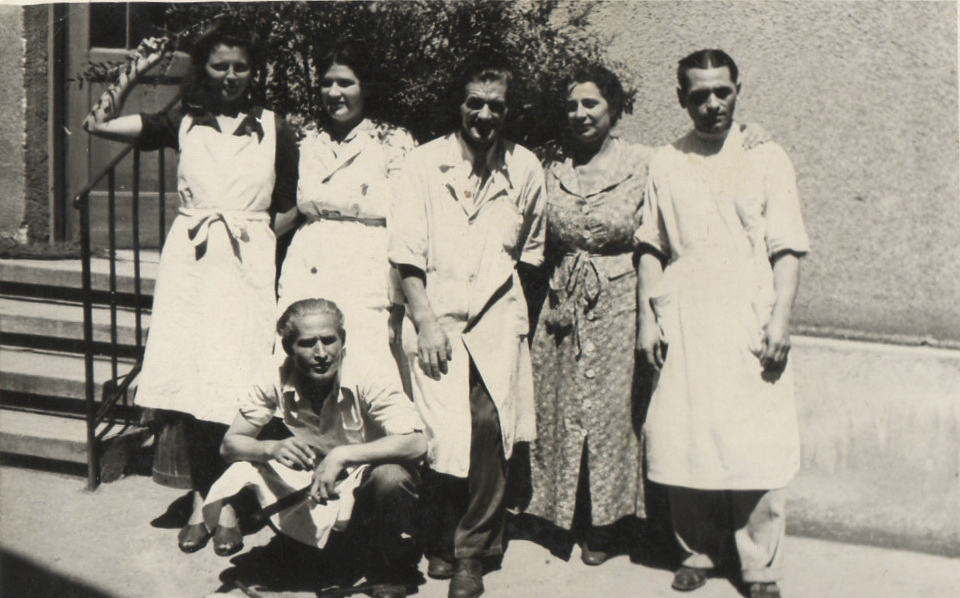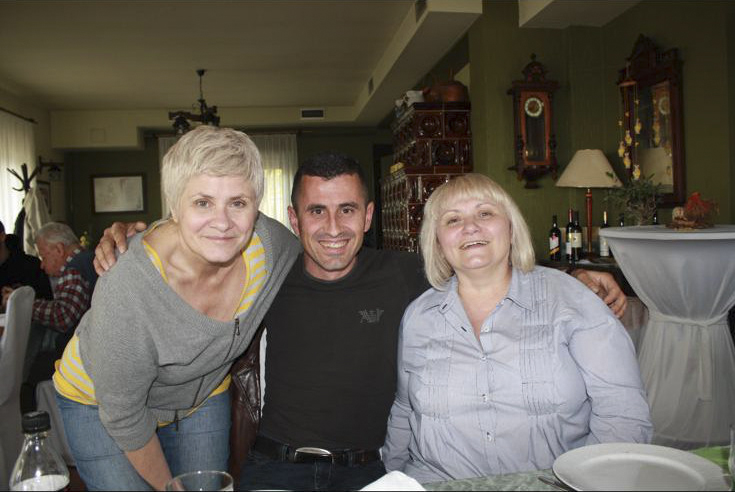“This is it,” he told his English wife.
“What are you waiting for,” she replied. “Go in!”
During his 2,500-kilometer road trip in July 2008 from west London to his family in the mountains of northern Albania, Festim Trota, then 30, sped through Europe with his wife and baby daughter, making just one overnight stop somewhere in Austria.
By noon on the second day, he entered Zagreb in his brand new VW Golf and took the Maksimirska road to the eastern part of the city. Slowing down to get the numbers right, he stopped and parked outside number 34, a gray three-story building with two or three stores on the ground level. One of the storefronts was a nondescript pastry shop whose golden storesign read “Orijent.”
Here he was.
He went inside and asked two young women at the counter about Zulfi Tahiri. Mr. Tahiri, they said, had died a few years earlier. “What about the owner?” Festim asked. A middle aged woman with short, blond hair approached. “Are you the daughter of Uncle Zulfi?” he asked her.
“Yes…”
“I am the son of Hasan Trota,” he said, “grandson to Hajrije.”
The woman paused for a moment. Her sister, who had been making pastries in the cellar below, came upstairs. The three of them sat at a table. “They wept, I wept,” he recalls, “I wept and they wept.”
They spent the next two days together. He showed them pictures of his father Hasan, who looked a lot like Zulfi. They visited Uncle Zulfi’s grave at Mirogoj, the city’s monumental cemetery. When the old man died in 2002 the funeral, done in the Muslim rite, they told him, was attended by hundreds. They gave Festim and his wife pastries (“Never had any I’ve ever eaten before or after melted in my mouth like those ones”), and took him and his family for a luxurious dinner.
Festim and his wife met all the Tahiris. The frail widow of Uncle Zulfi, who lived in an apartment nearby, gave him a golden bracelet for his baby daughter and the sisters brought baby food. The reunited family spent the night together. He was the first close member of their father’s Albanian family they had ever met.
At some point during the stay, he called his older brother in Albania to report. “I met them. Uncle Zulfi has died, I met his daughters and wife,” he said. But one thing surprised him. “His wife’s name was not Mejreme. It was something else.”
As a tiny pastry shop in a rather nondescript neighborhood — the place is only 12 meters by five and outside the city center — Slastičarnica Orijent might not impress an outsider. Yet, it is the oldest pastry shop running in Zagreb. With a devoted clientele (a “cult following” according to people of different generations I spoke to) across its various incarnations, it is in every guidebook and known all over the country and has been paid homage to in Yugoslav cult movies. Just last month, Index, the high-traffic Croatian portal, ran an article with Orijent’s recipes. Slastičarnica Orijent is an institution.
The road to Maksimir
Maksimirska is the road that connects the older Habsburg core of Zagreb to Maksimir Park, the 19th-century landscaped expanse, which at the time it was made sat well outside the city. Today Maksimir refers to Croatia’s largest football stadium, which sits just across the street from the park.
Along the road between Maksimir Park and the city center, artisans were invited to build houses and shops, developers built apartment blocks, and by the early 20th century the area had filled in. There was a Danubian assortment of shoemakers, ironsmiths, weavers, carpenters and butchers. There were Slovaks from Samobor, Germans from Vojvodina, Czechs, Hungarians and Slovenes, along with the Ottoman oddity, said Martina Petrinjak, whose grandfather, a shoemaker named Juraj Majdak, had been one of the early settlers there in the 1880s.
Sometime in the late 1920s an Albanian teenager introducing himself as Ahmet showed up on the street asking for a job at an ice cream shop run by a Muslim man. He sold cones from a street cart and slept in an attic room at the Majdak house across the street. He spent his first paycheck on an aluminium spoon.
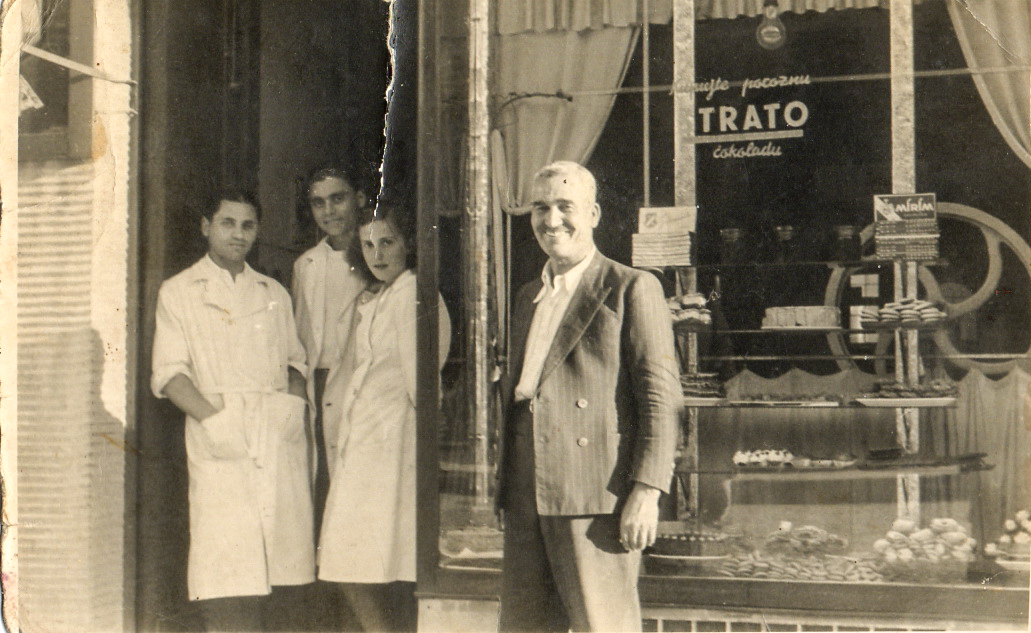
Zulfi Tahiri (left) went by the name Ahmet when he worked for the owner (right) of the ice cream shop Trato, the predecessor of Orijent. Photo: Courtesy of Andrija Sučević.
The man who hired him was so heavily in debt that one day in 1936 he disappeared. Ahmet seized the opportunity. With his savings and some loans, he paid the debt and bought the business license and the store.
You can almost see this story about to transpire in a picture of the staff in front of the shop from 1935. The owner, to the right, has a carefree smile under his moustache. Ahmet, in the left hand corner, looks quiet and unassuming, but determined.
Slastičarnica Orijent
When Ahmet took over and rebranded the shop as “Orijent,” it really took off. Besides when the shop was briefly nationalized after World War Two, things went well. Maksimirska expanded along with the rest of Zagreb, and that meant more kids buying ice cream and more families seeking to make their children happy. “If you had your kid’s birthday coming up, that was the place to go for the cake,” Andrea Rizova, a health practitioner who grew up in the area, told me.
In the late ’40s, Ahmet hired as a janitor a joyful and hard-working girl from the countryside west of Zagreb who was five centimeters taller and 14 years younger than him. Her name was Amalija, but she went by the diminutive of Malčika. He liked her and asked the Majdak patriarch whether she would be a good fit. The man thought that to Ahmet “good fit” meant “virgin.” Juraj’s answer, passed down through Majdak family legend, was, “How the hell would I know?”
Ahmet was disheartened at the insensitivity, but he continued to court her. He told her he had once been married and showed her a picture of his deceased wife. Later he told friends that he had actually shown her a picture of Queen Geraldine of Albania. He and Malčika married.
It was the best decision he ever made, one that quickly brought two daughters. Malčika named the first one Šeherezada, after the character from the 1942 Hollywood classic Arabian Nights, and some Albanian friends from Bosnia chose the name Ildeza for the second. Ahmet was the now somber face behind fantastic sweets, Malčika was the caring matron who cheered up the place.
Their ice creams and pastries were luxurious — he never cut corners on ingredients. The ice cream section was full of the standard vanilla, strawberry, chocolate, noisette and apricot. Then there were the cakes. Doboš cakes and fruit or chestnut parfaits. Rolls filled with chocolate or šaum (cream froth), creamy cake slices, strudels and then the minjoni, white and chocolate tidbits.
The baklava servings were generous, and even the minjoni, which elsewhere would be petit fours, hence tiny, here were the size of a donut, Rizova recalled. Come winter, tea biscuits and marzipan piglets replaced the ice cream.
The interior decorations were disarmingly chintzy. As you entered, to the right, there was the counter, but to the left, chandeliers hovered above the tables, large model butterflies and posters of Asian women under sun umbrellas were glued to the wall, as were faded pinups of Hollywood stars from the 1950s (Harry Belafonte, Maria Montero…). On your way out, passing through the scent of vanilla and powdered sugar, you would see a man scraping the ice cream with the wooden shovel from the machine near the door, and putting it into boxes.
“We stared in amazement at how ice cream was born that way,” renowned Croatian film director Rajko Grlić, now 73, reminisced in a message to me. Grlić grew up in a neighborhood half an hour from Orijent. “Whenever we collected some money [as kids], we went there,” he said.
Tahiri (and the pastry shop) found a rhythm. He began to be known by his real name, Zulfi, and in the ’50s he bought an apartment in the neighborhood and by the ’70s, a holiday home in the Dalmatian islands.
He bought season tickets for Zagreb’s Dinamo football club and then supplied its players with his famous kremšnite, his daughters said. He donated to the Zagreb-Split highway fund and to the Red Cross. He gave money for the construction of the city mosque in the ’80s, so that they would not have to pray in apartments any more. He once resuscitated his pet canary back to life, his grandson Andrija said.
And though he would have preferred his daughters marry Albanian Muslims, when they married Croats he took it in stride and doted on his grandchildren.
But mostly, he and Malčika worked. “He wouldn’t even enjoy his summer house that much,” said Riza Noka, an Albanian friend who knew Zulfi. “He feared something terrible would happen to the shop if he wasn’t there.”
Even after that many years, he would still mix up noun genders in his vernacular Zagreb dialect, but even his Albanian now sounded outdated. “I had trouble understanding it,” Noka joked.
As he grew older, he would occasionally have a glass of beer.
What a romp!
When Zulfi retired in 1987 his college-educated daughters took over and decided to give Orijent an edge. They remodeled it in the Yugo aesthetics of the time, added more chairs and replaced the equipment. Gone were the arabesque trinkets, the wall decorations were now spare and they put in a marble floor and granite-top tables. A soft blue hue was a nod to Dinamo’s colors. It felt elegant.
They had fun with it. Ice creams or cakes were given playful names. Cakes topped with plums, chestnuts and poppy seeds were named Jesen stiže (Autumn is coming). The holiday greeting card slogan Pozdrav s juga (Greetings from the South) was the name of their lemon and lavender pastry. Each character from “Sex and the City” had a cake named in their honor.
Lito vilovito (The Enchanted Summer) is a ’60s comedy about Dalmatian Lotharios. At Orijent, there’s an ice cream named for that too, with figs, olive oil and prošek wine.
When they lacked creative ideas, they’d ask for suggestions on social media.
The childhoods of newer generations were being molded, replacing the set pieces of earlier childhoods. “I was sorry for that cheap iconography of the East that was in the original arrangement, which blended so harmoniously with the ice cream and boyish dreams of the Far East,” Grlić, the film director, said.
As Zulfi aged, the old man was usually still at the shop, sipping his tea or espresso at the table next to the counter. As dementia set in, he became less involved, though he always weighed in and helped. He did marzipan piglets for New Year until he passed away, said his nephew Andrija, but he couldn’t recognize Andrija.
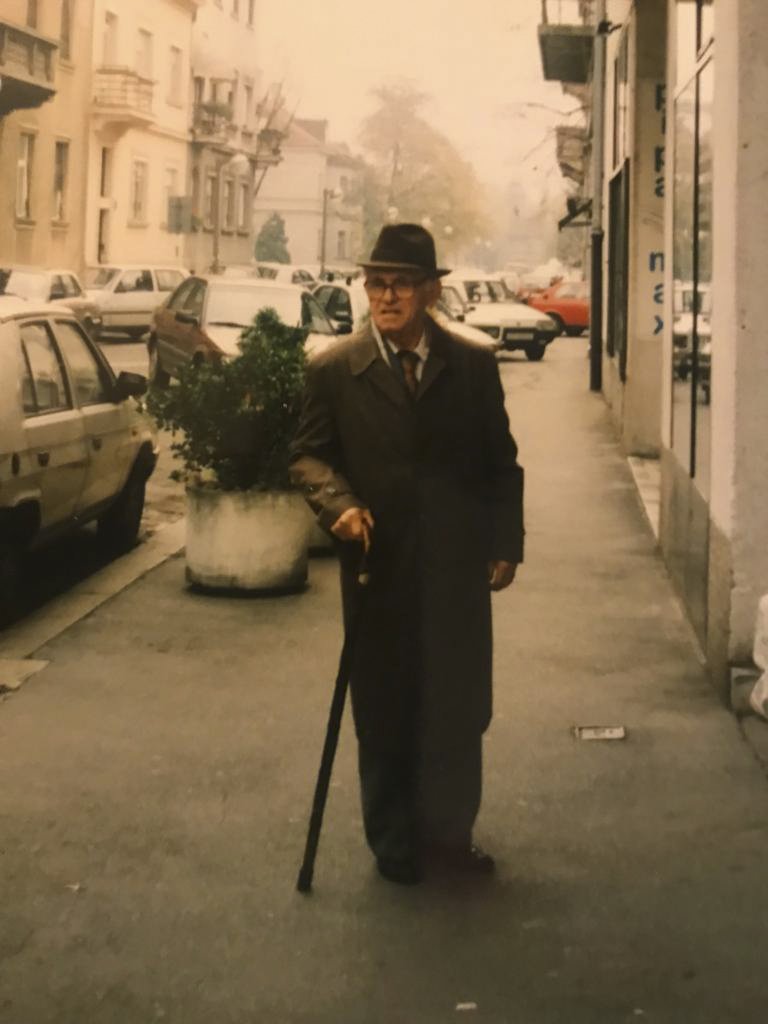
Zulfi Tahiri, pictured here in the mid 1990s, continued to spend his time at the shop after he retired. Even after dementia set in, he still knew how to help out around the kitchen. Photo: Courtesy of Šeherezada Tahiri-Sučević and Ildeza Tahiri Martelanc.
When his daughters asked Zulfi whether he knew his nephew, he would say, “Of course, he’s the Albanian.” He still dreamed in Albanian. And he still ate with the aluminium spoon he bought when he first arrived in Zagreb.
Martina Petrinjak had a soft spot for him. “I miss the plain, familiar ice cream he was so good at,” the 52-year-old former architect and current bookseller told me. “He had that twinge of an accent. I couldn’t make out where it came from.”
“You’d figure out the accents in Croatian of the Germans, the Czechs or the others. You could even make out the accents of Janjevo Croats [from Kosovo] who have been here for two generations,” Petrinjak said. “But not his. His Croatian was different from the Kosovo Albanians, who had learned it by initially speaking Serbian. He had learned it here.”
Ahmet’s Albanian story
How would Albanians end up in a place like Zagreb? I was familiar with the Yugoslav phenomenon of the poor South looking for opportunities in the wealthier North. For example, in Zagreb there’s a Catholic Albanian community from Kosovo who ran photography businesses and jewelry shops. And since the ’60s, when Croatia experienced a tourism boom, Muslim Albanians from Kosovo came to run bakeries, and many from Macedonia ran ice cream businesses along the Dalmatian coast. There were also university students.
It was a jewelry artist of the older generation who first mentioned Zulfi Tahiri to me. Lazër Lumezi, then in his twenties, had run into him in a small Albanian gathering around a coffee table sometime in the ’70s. The ice cream maker was so excited to meet Lumezi that he gave him “The Highland Lute,” a 17,000-verse tome of Albanian epic poetry. But the friendship quickly soured when Lumezi said, “If Enver Hoxha got one thing right in Albania, it was to ban religion.” Two days later, Tahiri wanted his book back.
Tahiri had told Lumezi that he had come to Zagreb straight from Albania.
I later learned that the place he came from was Shtreza, a remote hamlet of three dozen households in the northeastern part of the country, 25 kilometers south of Kukës. His father Tahir — from whom he got the old-fashioned surname, the family name is Gjuta — had a sizable flock of sheep that he kept on a gentle slope the family owned. But at some point both of Zulfi’s parents had died. Around 1920, his older brother was killed in an altercation and he was left alone with his two younger sisters.
He left in 1923 to join two families from the village who had settled in Tuzla, a city in northeastern Bosnia. After spending a year or two there and some time in Split he moved to Zagreb around 1928. He did odd jobs before getting hired by the Muslim shop owner on Maksimirska. He would recall later the hay mattresses inside workshops where he had slept to save money.
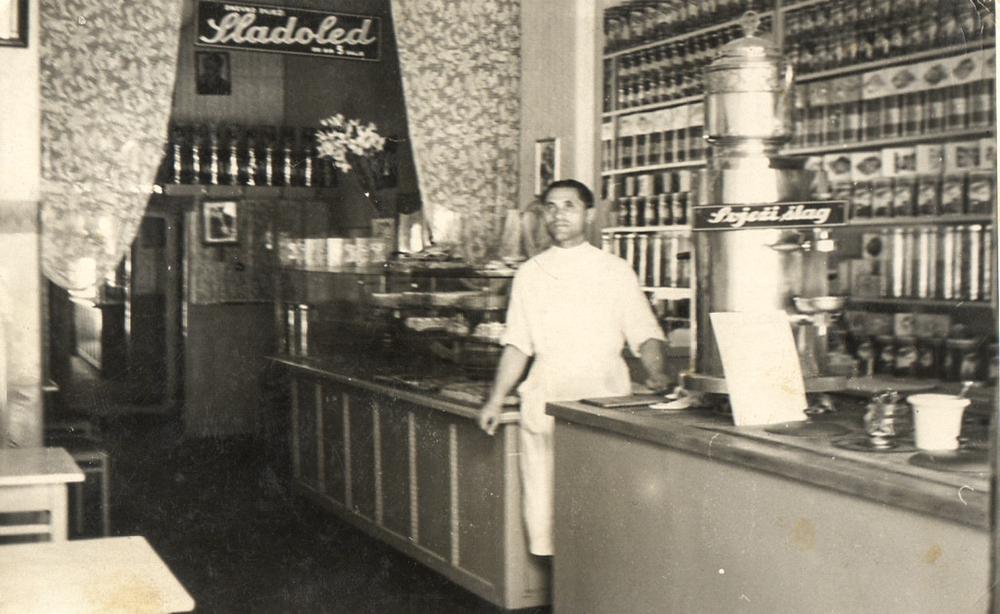
Zulfi Tahiri, pictured here in the 1940s, returned to his home village in Albania sometime during the Second World War to get married. Photo: Courtesy of Andrija Sučević.
Once his ice cream business stabilized, sometime during the Second World War, he went to his home village to rebuild his house and marry his first wife Mejreme. The people of Shtreza remembered the surprise at watching him play a mandolin he brought with him. He, in return, was baffled to find that the task of announcing to the village that Italy (which had occupied Albania) had capitulated a few months earlier fell to him.
After the war, Mejreme fell sick from a debilitating ailment, perhaps tuberculosis, and around 1948 a relative took her illegally to Prizren, in Kosovo, so that she could visit a doctor. But it was hopeless. Tahiri begged his sisters, by then married in a village closer to Kukës, to join him in Croatia, but they refused, for they knew nobody there.
By then, the rulers of the two countries, Albania’s Hoxha and Yugoslavia’s Tito, had a vicious Cold War fallout, and the borders were sealed. Tahiri gave up any hope of returning and he would barely talk about his former life to his new family. To Albanian friends in Zagreb he would confess the pain he felt over his brother’s death going unavenged, and that he knew the murderer to be living somewhere in Belgium. But he had to look forward.
Sometime in the ’80s, his son-in-law took him to Kosovo to meet friends. They drove to the rugged border between Kosovo and Albania. When they reached it, they could not see anything on the other side because of rain clouds. But at some point, as they waited, the clouds cleared up and Zulfi could see the mountains that looked over Shtreza. This would be the last time he made it that close, Ildeza said.
Albanian relatives
Growing up in Albania in the ’60s, Hasan Trota, the son of Zulfi’s sister Hajrije, used to curse his parents for not following Uncle Zulfi to Croatia. He would write his uncle letters asking him to take him out of Albania, and to avoid police monitoring, he would go to other towns to mail them, Hasan’s son Selman told me. He tried this three or four times before giving up, starting a family and getting a job as a mechanic on a state farm.
The family did manage to maintain some correspondence. Uncle Zulfi once sent a color TV, and another time he sent a Sanyo cassette recorder with a New Year’s greeting on a cassette — almost no one had color TVs or cassette recorders in the country when the Trotas did. They knew their uncle had two daughters, he had sent a family photo, but they knew little else.
When Albania opened up in the ’90s a distant relative asked Zulfi to send a motorcycle. Another one popped up at the shop in Zagreb after being caught trying to reach Germany illegally. He asked for money to get back home.
Shtreza, the village Tahiri was born in, is now all but abandoned, his ancestral house in ruins. The area is in perpetual economic slump. Most men have left, either going to bigger cities or to the west.
Festim Trota came to the UK through marriage. He met his partner while working at a resort in Greece. He’s had his share of odd jobs and now lays pipes in the Cambridge area and lives in a village north of London. “You know, deep down I am a country boy,” he told me. He goes to Albania often.
A few years after meeting the Tahiri sisters, Trota took his older brother Selman on a roadtrip across Europe in his brand new BMW. Albanians had just gained the right to visa-free travel in the Schengen zone, and Selman had never really been to Europe. All he had seen was the UK, where his brother lived, and Greece, where he looked for menial jobs in the ’90s. They passed by the patisserie on their way to Brussels, from where Selman would fly back home, but Orijent was closed for August, the month when the sisters summer at their cottage in the Dalmatian islands.
As Festim was telling me his story, I began to fathom the dense fog that had separated the Albanian ice cream vendor in Zagreb from his long-lost Albanian relatives. So little information had made its way across the border that the few facts Festim initially thought he knew about his uncle’s family were mixed up. For example, Festim told me the sisters had been vacationing in Tuzla on the coast. He was confusing the Bosnian town where his uncle had first lived in Yugoslavia almost a century earlier with the small Dalmatian island of Murter, where the family’s summer cottage is.
Though Festim could not recall exactly what had happened with Mejreme, he knew that she had been sick, and that “Uncle Zulfi wanted to pay the doctor his weight in gold if he would get her better.” A relative of Tahiri’s I spoke to this summer in Albania told me he was convinced that Tahiri had become one of the top ten richest people of Croatia, claiming that Tahiri owned large apartment blocks and top tier hotels there. He had become, as one relative put it, “the bey of Zagreb.”
Festim has not been to Zagreb since, though he keeps in touch with his relatives there and hopes to visit again sometime. “You know,” he told me, “People drift apart after living so long away from each other.” But his daughter, a teenager now, still carries the bracelet she received from her great great-aunt as a baby.
The oldest pastry shop
Their seventies now in sight, the Tahiri sisters recently retired and sold the shop outside the immediate family. If the business was to survive, it needed to expand, and they did not have enough money, Šeherezada told me, and the sisters’ children were not interested. One teaches English in Japan, another is a lawyer and the third, Andrija, is an engineer with the European Space Agency in Germany. The sisters are now looking forward to traveling the world.
There was sadness in Zagreb, but the family still holds some shares in the enterprise, and Šeherezada still provides them with recipes. Right before the pandemic began, Orijent opened a new store just off the city’s main square.
Grlić, the film director, included a 50-second scene filmed at the shop for the TV adaptation of his 1984 film “U raljama života” (In the Jaws of Life), well-known across Yugoslavia. The naive teenage character walks into kitschy settings, including this one, to emphasize her kitschy life. But rather than mocking the establishment, for Grlić the scene was a small tribute to the Orijent of his childhood.
Four years ago, Zulfi’s grandson Andrija posted the clip online. Among the several nostalgic comments about the ice cream shop in Croatian, there was a single one in Albanian. “My father’s uncle,” Selman Trota wrote.
The man in Albania who told me of the exorbitant wealth of the Tahiris runs a small pastry shop on the outskirts of Tirana. He said that the previous spring he went around the house in Shtreza with a metal detector. There was a long-running rumor that Zulfi stashed the gold his father accumulated after selling all his livestock — along with gold he is said to have sent home from Croatia before Communism — somewhere in the village. He found nothing. “It’s something I do every ten years or so,” he told me. “There may be nothing there.”
The two sisters are not sure why their father, when he moved to Zagreb, was using the name Ahmet. He had told the family that he took the name of the boss that had disappeared in 1936. At times, they wondered whether he may have initially wanted to hide something. They may never know the answer. Such a long time has passed. In fact, a Croatian researcher told Ildeza last October that, in all likelihood, theirs was the oldest Albanian family in town.
Feature image: Courtesy of Andrija Sučević.


This article has been produced with the financial support of the “Balkan Trust for Democracy,” a project of the German Marshall Fund of the United States and the Norwegian Ministry of Foreign Affairs. Opinions expressed in this article do not necessarily represent those of the Norwegian Ministry of Foreign Affairs, the Balkan Trust for Democracy, the German Marshall Fund of the United States, or its partners.


